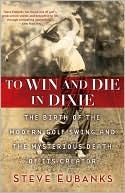To Win and Die in Dixie: The birth of the modern golf swing and the mysterious death of its creator
As with most other sports, golf can be a wonderful cocoon against the outside world, where the cares and responsibilities of life can be set aside for a few hours in pursuit of sporting triumph, however defined.
Governed by a series of imperious rules that artificially fence in the player’s options for achieving those goals, golf also insists that compliance with those rules provides a way to test one’s makeup, beyond the confines of the sport.
Perhaps no other game claims that it provides an opportunity to reveal character, as opposed to building it.
Nonetheless, the real world has a bad habit of intruding into the artificial ones we create.
Steve Eubanks’ new book is a timely reminder of these facts of life, with his detailed study of the death of one of the inventors of the modern game.
J. Douglas Edgar is not well known to most golfers nowadays, but in the late teens and early twenties of the last century, plenty of folks knew all about him. He set a longstanding competitive scoring record in his first victory in the Canadian Open, and followed it up with a successful defense of his title the next year.
It wasn’t so much that Edgar won, or how low he went when he did. While trying to figure out how to play with a bad hip condition, Edgar invented what we now know as the modern golf swing. Its emphasis on building torque between the upper and lower halves of the body, with the downward move beginning with a hip turn instead of the arm swing, led to a huge boost in Edgar’s distance and control. When he was “on,” Edgar was simply unbeatable.
Like others of his era, Edgar’s tournament play was an adjunct for his regular work as the golf pro for a club, in his case an upscale layout in Atlanta, Georgia. Two famous golfers, Bobby Jones and U.S. Women’s Amateur winner Alexa Stirling, learned the game and Edgar’s swing under his tutelage.
In mid-summer 1921, however, Edgar’s increasingly charmed life came to a swift and violent end. The initial impression was that he was a victim of a hit-and-run accident with a car. This scenario fit in nicely with the growing consensus in Atlanta and elsewhere that something had to be done about safety and traffic conditions, as more and more cars filled the streets in the aftermath of World War I.
An Atlanta Constitution reporter, Comer Howell, was among the first to the scene, as Edgar bled out on the streets. He also thought at first that a car had hit Edgar. It was only later that Howell came to believe that something far more sinister caused Edgar’s demise.
Working from transcripts of the coroner’s inquest, court papers, and other contemporary accounts, in addition to Howell’s notes, Eubanks shows the reader that Howell was most likely correct about the cause of Edgar’s untimely passing.
While highly accomplished on the golf course, Edgar’s personal life was far less exemplary. He enjoyed more than the occasional cocktail, and Prohibition didn’t help matters. He was generous to a fault with his money, to the point of profligacy. His immaturity in that respect led to strict financial controls by his club’s management
In addition, although married and the father of two children, there are indications that he often enjoyed other female companionship, as a reward of sorts for his athletic prowess.
Some things don’t change over time, apparently.
Some of Edgar’s circumstances are more tightly tied to his times, however. Atlanta was a Southern bastion of the early twenties, with blatant appeals to racism marring political, social, and economic life in Georgia. An English immigrant, Edgar did not appear to be tied to local mores in these respects.
As Eubanks shows, that fact may have been a critical element in explaining why Edgar was killed.
This book is a fascinating glimpse at a part of golf’s history that has not been given as much attention as it deserves. The mystery of Edgar’s death almost certainly provides part of the explanation for why that is so. Sports biographies tend to emphasize the positive over a fuller understanding of a game’s heroes, and in Edgar’s case, that was no easy task.
Eubanks should be commended for not following the usual script with this great story.
Review Date: May 31, 2010


